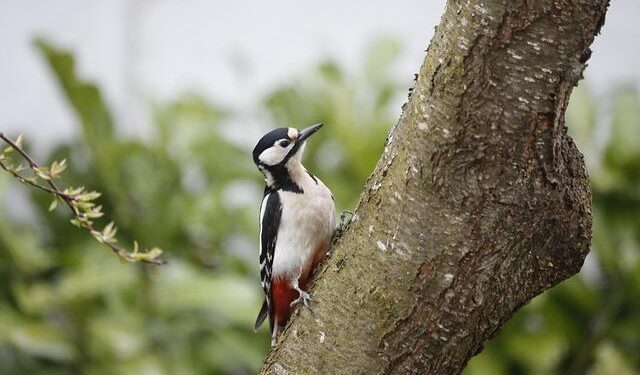Woodpeckers may be better known for their rhythmic drumming on tree trunks, but new research reveals they also communicate in a surprisingly human-like way: through grunts reminiscent of tennis players’ vocalizations during a match. Scientists studying these birds have uncovered that woodpeckers produce low-frequency calls that not only serve as social signals but also echo the intensity and timing found in the grunts of athletes striving for an edge. This unexpected parallel offers fresh insights into animal communication and the convergent evolution of sound patterns across species.
How Woodpeckers Use Grunts to Communicate Like Tennis Players
Much like tennis players use grunts to signal intensity or rhythm during a match, woodpeckers have developed a sophisticated “grunt language” that serves multiple communication purposes. Researchers have discovered that these birds emit a range of guttural sounds, especially grunts, to establish territory, attract mates, and even coordinate with their offspring. These vocalizations, paired with their characteristic drumming, form a unique acoustic code that rivals the nuanced expressions found in human sports. Unlike the abrupt pecking rhythms that punctuate their presence visually, grunts provide a more subtle but equally powerful medium for conveying mood and intent across the forest canopy.
The parallels between woodpeckers and tennis players extend beyond the simple act of grunting. Both use these sounds deliberately to influence their environment or opponents. In woodpeckers, grunts can vary in pitch and duration, creating a spectrum of meanings understood by other birds within earshot. This communication style has evolved as an adaptive strategy, ensuring survival amidst the cacophony of woodland life. Consider the following breakdown of grunt functions:
- Territorial Defense: Low-frequency grunts warn rival woodpeckers to stay away.
- Mating Calls: Softer, rhythmic grunts entice potential partners.
- Parental Guidance: Parent birds use short grunts to guide chicks during feeding.
| Type of Grunt | Purpose | Typical Duration |
|---|---|---|
| Low-frequency rumble | Territorial Warning | 1.2 – 2 seconds |
| Short, repetitive grunts | Mating Attraction | 0.5 – 1 second |
| Quick chirp-like grunts | Parent-Offspring Communication | 0.3 – 0.6 seconds |
The Science Behind the Strange Sounds of Woodpeckers’ Calls
Woodpeckers produce some of the most unusual vocalizations in the bird world, often described as grunts or chirps that seem oddly reminiscent of the sounds made by athletes during high-intensity moments-like tennis players grunting during a serve. These calls are not mere chance noises but serve vital roles in communication, territory defense, and mating rituals. At the heart of this acoustic phenomenon lies a specialized syrinx-the avian equivalent of vocal cords-that allows woodpeckers to modulate pitch and volume with remarkable precision. Unlike other birds that rely heavily on melodic songs, woodpeckers emphasize rhythmic grunts and percussive sounds, which can carry through dense forests and vibrate tree trunks, acting as both audible and tactile signals.
Researchers have uncovered several fascinating aspects behind these grunting calls, summarized as follows:
- Frequency modulation: Woodpeckers adjust their grunts in frequency to communicate different messages such as warnings or courtship signals.
- Body resonance: The structure of their heads and neck muscles helps amplify vibrations, giving calls a punchy, resonant quality.
- Behavioral mimicry: Some studies suggest a correlation between the woodpecker’s grunting and human exertion sounds, providing an unexpected parallel in natural and human expressions of effort.
| Call Type | Frequency Range (Hz) | Purpose |
|---|---|---|
| Short Grunt | 500 – 800 | Territorial warning |
| Rapid Series | 800 – 1200 | Mating display |
| Low Thump | 200 – 400 | Communication within family group |
What This Discovery Means for Birdwatchers and Wildlife Enthusiasts
For birdwatchers and wildlife enthusiasts, this fascinating discovery offers an entirely new dimension to observing woodpeckers. Traditionally admired for their rhythmic drumming, woodpeckers now reveal a subtler side to their communication – the low-frequency grunts that resemble the vocal cues of tennis players signaling points or fouls. Recognizing these sounds can deepen the field experience, allowing enthusiasts to identify woodpecker presence even when visual cues are scarce. This auditory insight enhances the chances of successful spotting and enriches understanding of woodpecker behavior beyond their iconic pecking patterns.
Moreover, understanding these vocalizations opens the door to fresh research and in-the-field monitoring techniques. Enthusiasts can utilize simple audio recording tools to capture and analyze these grunts, contributing valuable citizen-science data. Below is a quick guide to tell these woodpecker grunts apart from other forest sounds:
- Duration: Grunts last about 0.2 seconds – notably shorter than most bird calls.
- Pitch: Low-frequency range, often below 1 kHz, distinct from the higher-pitched chirps of songbirds.
- Pattern: Typically repetitive with brief pauses, similar to the rhythmic chant of a tennis player’s grunt.
| Characteristic | Woodpecker Grunts | Common Forest Sounds |
|---|---|---|
| Frequency | Below 1 kHz | Above 2 kHz |
| Duration | ~0.2 seconds | Varies, usually longer |
| Pattern | Short, repetitive bursts | Irregular or melodic |
Concluding Remarks
As research continues to uncover the surprising parallels between woodpecker communication and human athletics, this study adds a new dimension to our understanding of animal behavior. By revealing that woodpeckers use grunts reminiscent of tennis players’ sounds, scientists open the door to further exploration of how acoustic signals function across species. This unexpected connection underscores the complexity of nature’s communication networks and invites both researchers and the public to listen more closely to the rhythms of the natural world.































